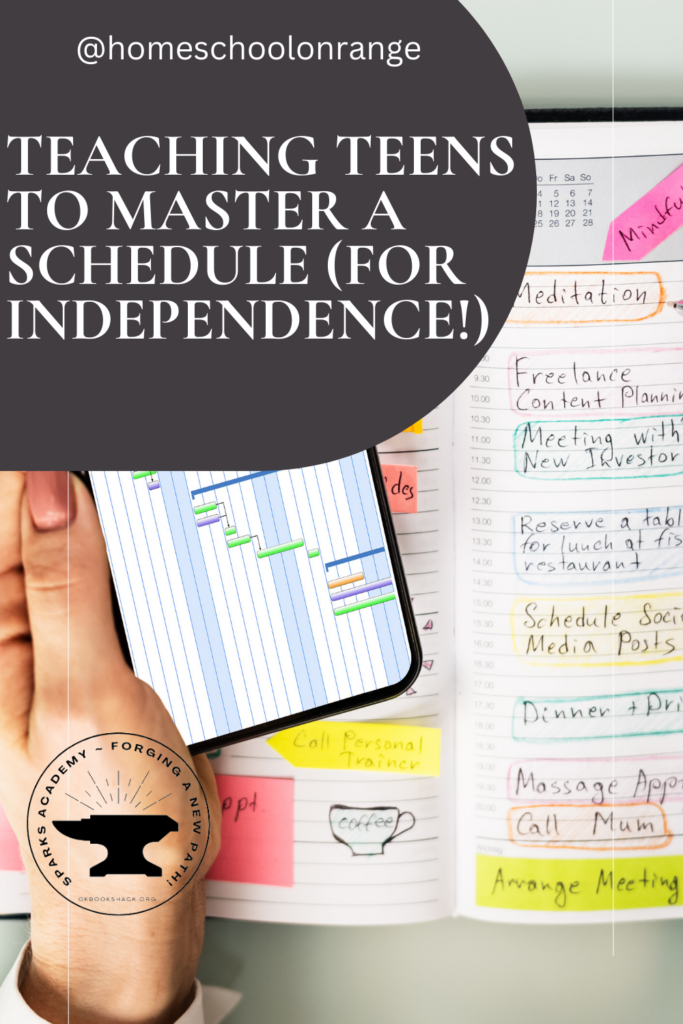
One of the challenges of transitioning to high school and post-graduate years is developing the independence. It doesn’t happen overnight, and students need support as they move away from parent-led schooling into independent-schooling. Here are some study tips to help champion your student!
Why work on independence in the school day?
- Frees mom up to work with younger siblings or provide one-on-one instruction as needed
- Boosts problem-solving skills and allows them to develop their own ‘groove’
- Hands over the responsibility for both setting a schedule and completing the work
Maintain communication.
This is not the time to just let go of the strings and see what happens. Check in with your kids on a regular basis, be that every few hours, once a day, or once a week (this will depend on the kid and what’s going on at any given time). Review what has been done and what is coming up next. This will help them stay focused and on track, plus it will give both of you a structure to work around.
By outsourcing courses, students also learn to be responsible to someone other than mom and dad, but still have parental support and oversight. At Sparks Academy, for example, students are provided a schedule and taught in teacher-led and teacher-graded courses, but parents are sent a quarterly newsletter and progress report as a reminder to check in regularly.
Set the right tone.
If your student isn’t sure about their learning style, have them take this free quiz. By learning and playing toward learning style strengths, students are more likely to maximize their study time and improve their academic performance. This might include working with music or wearing noise-cancelling headphones, working in a brightly lit or dim area, working with others or working alone. Additionally, you’ll want a comfortable chair or desk, adequate supplies, and a place to spread out books and resources.
Unless being used specifically for academic purposes, electronics should be put away during school time to limit distractions. This is particularly true for students with ADHD or other special needs. You might even go as far as to use a scheduler to block social media sites during school time, if needed. By setting the right tone, your student will have a better chance of staying focused on the tasks at hand.
Read: Teaching the Distracted Student
Manage time wisely.
Probably the most important skill your teen will learn is time management, which translates across all aspects of life, not just academics. Students need to learn to prioritize tasks (we call it triage in our house) and set the pace for completing those tasks. Rather than constantly telling them what to be doing when, allow them to take a set of tasks, prioritize them, and complete them in their own time (with a set deadline).
Be sure to enforce the deadlines, too, even though there will be times when they don’t meet them and need some sort of natural consequence. When this happens, it’s a good time to work on ‘working backward,’ taking a large task, breaking it into smaller tasks, and scheduling each in order to meet a deadline. Whether in college or on the job, there are always deadlines to be met and someone to answer to for our responsibilities…and by allowing them to start developing those skills now, you’re giving them a leg up.
Set Manageable Goals.
Checklists are wonders. They can really keep a person on track, be that mom trying to accomplish all the things or students trying to remember assignments. By learning to use planners and checklists in high school, students can find a system of organization that works best for them and will set them up for better success post-graduation. There are both physical and digital planners, and there is no right or wrong option…only the one that is right for them! As a bonus, planners (particularly physical ones) can be used as documentation of academic assignments and performance. Just toss it aside at the end of each semester or year to have on-hand if needed.
Read: Five Best Planners for Teens
Develop a System.
Note-taking used to be much more common than it is now, and even when teens are taking notes these days, it tends to be digitally. However, there is so much to be said for learning to take hand-written notes. Using old-fashioned pen and paper engages several senses and an area of the brain that facilitates learning. Follow these four rules for note-taking, and you should see marked improvement in your academics: be prepared, write neatly, stay organized, and write down questions.
There are as many different forms of note-taking as there are students. You’ll need to find what works best for your learning. Visit this post on Note-Taking for Teens to learn about several different styles and to learn more about teaching the art of taking notes.
Look for more in-depth discussion of this topic and more in Through the Door: Homeschool to College Success! This book & worktext set will help you and your high school student breeze through the steps of college and scholarship applications, as well as brushing up on study habits and life skills. The worktext includes activities, worksheets, and planning pages, and accompanies the book.


